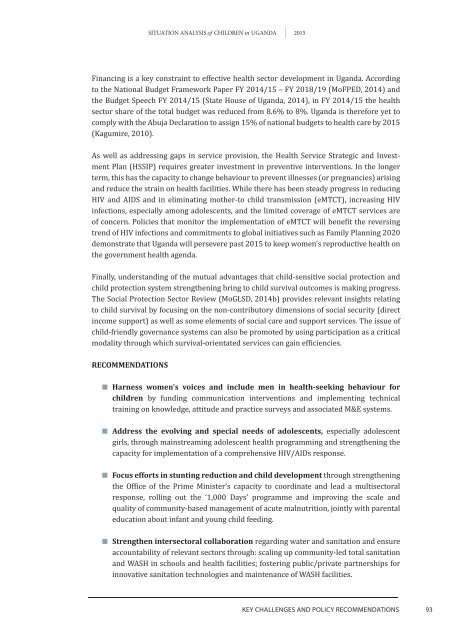Situation analySiS
1TNu802
1TNu802
Create successful ePaper yourself
Turn your PDF publications into a flip-book with our unique Google optimized e-Paper software.
<strong>Situation</strong> <strong>analySiS</strong> of Children in uganda 2015Financing is a key constraint to effective health sector development in Uganda. Accordingto the National Budget Framework Paper FY 2014/15 – FY 2018/19 (MoFPED, 2014) andthe Budget Speech FY 2014/15 (State House of Uganda, 2014), in FY 2014/15 the healthsector share of the total budget was reduced from 8.6% to 8%. Uganda is therefore yet tocomply with the Abuja Declaration to assign 15% of national budgets to health care by 2015(Kagumire, 2010).As well as addressing gaps in service provision, the Health Service Strategic and InvestmentPlan (HSSIP) requires greater investment in preventive interventions. In the longerterm, this has the capacity to change behaviour to prevent illnesses (or pregnancies) arisingand reduce the strain on health facilities. While there has been steady progress in reducingHIV and AIDS and in eliminating mother-to child transmission (eMTCT), increasing HIVinfections, especially among adolescents, and the limited coverage of eMTCT services areof concern. Policies that monitor the implementation of eMTCT will benefit the reversingtrend of HIV infections and commitments to global initiatives such as Family Planning 2020demonstrate that Uganda will persevere past 2015 to keep women’s reproductive health onthe government health agenda.Finally, understanding of the mutual advantages that child-sensitive social protection andchild protection system strengthening bring to child survival outcomes is making progress.The Social Protection Sector Review (MoGLSD, 2014b) provides relevant insights relatingto child survival by focusing on the non-contributory dimensions of social security (directincome support) as well as some elements of social care and support services. The issue ofchild-friendly governance systems can also be promoted by using participation as a criticalmodality through which survival-orientated services can gain efficiencies.RECOMMENDATIONSHarness women’s voices and include men in health-seeking behaviour forchildren by funding communication interventions and implementing technicaltraining on knowledge, attitude and practice surveys and associated M&E systems.Address the evolving and special needs of adolescents, especially adolescentgirls, through mainstreaming adolescent health programming and strengthening thecapacity for implementation of a comprehensive HIV/AIDs response.Focus efforts in stunting reduction and child development through strengtheningthe office of the Prime Minister’s capacity to coordinate and lead a multisectoralresponse, rolling out the ‘1,000 Days’ programme and improving the scale andquality of community-based management of acute malnutrition, jointly with parentaleducation about infant and young child feeding.Strengthen intersectoral collaboration regarding water and sanitation and ensureaccountability of relevant sectors through: scaling up community-led total sanitationand WASH in schools and health facilities; fostering public/private partnerships forinnovative sanitation technologies and maintenance of WASH facilities.KEy ChaLLENGES aND PoLICy rECoMMENDatIoNS93




